| The T-34-85 Medium Tank |
|---|
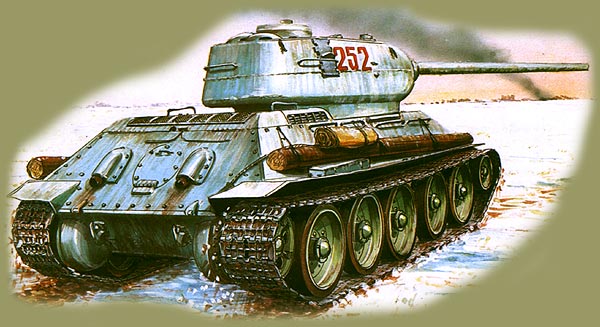
Attempts at re-arming the T-34 were undertaken beginning in 1942, as the culmination of program of ongoing modernisation to eliminate the T-34's shortcomings. The T-43 medium tank design is the first such that should be mentioned here. It was designed taking into account improvements requested for the T-34: perfecting the suspension, increasing the size of the crew compartment, and improving armor protection. In addition, it made active use of the design work done on the pre-war T-34M tank.
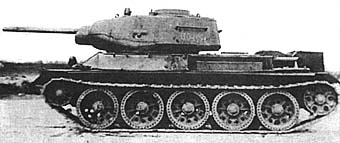 The T-43 medium tank |
The new combat vehicle was 78.5% interchangeable with the "thirty-four" series. The design of T-43's hull remained basically the same as the former's, as did the engine, transmission, chassis, and cannon. Despite claims that periodically occur in print, the basic difference was an increase in the frontal, side, and rear plates to 75 mm on the hull, 90 mm on the turret.
At the end of August, a conference was held at Factory #112. It was attended by the People's Commissar for Tank Industry V.A.Malyshev, Commander of Tank and Mechanized Troops of the Red Army Ya.N.Fedorenko, and ranking members from the People's Commissariat for Armaments. In his introduction, V.A.Malyshev noted that the victory at the Battle of Kursk cost the Red Army a high price:
"Enemy tanks opened fire on ours at distances of up to 1,500 metres, while our 76 mm tank guns could destroy "Tigers" and "Panthers" at distances of only 500-600 metres. Imagine the enemy has a kilometer and a half in his hands, while we have only half a kilometer. A more powerful gun needs to be put into the T-34 quickly."
In actual fact, the situation was significantly worse than Malyshev painted it, though attempts to correct the situation had been undertaken at the beginning of 1943. As early as the 15th of April, the GOKO, reacting to the appearance of the new German tanks on the Soviet-German front, published order #3187ss (the "ss" suffix means top secret) "Measures for improving anti-tank defenses." This required the GAU (Glavnoye Artilleriiskoye Upravleniye, Chief Artillery Directorate) to put all tank and anti-tank guns then in mass production through range trials, and present findings all within a 10 day period. In accordance with this order, Deputy Commander of Tank and Mechanized Forces Lieutenant-General V.M.Korobkov ordered that a captured "Tiger" be used for the trials, which were conducted from 25 to 30 April at the NIIBT (Nauchno-issledovatel'skii Institut Bronetankovoi Tekhniki, Armored Vehicle Research and Development Institute) proving grounds at Kubinka. The trial results were of little comfort. The 76 mm armored-piercing tracer round for the F-34 gun did not penetrate the German tank's side even as close as 200 metres! The most effective weapon for dealing with the enemy's new heavy tank turned out to be the 85mm 52-K anti-aircraft gun model 1939. It penetrated the 100 mm frontal armor at distances up to 1,000 metres. |
On 5 May 1943 the GOKO approved order #3289ss "Improving tank and assault-gun cannon armament." This gave the NKTP and NKB the specific task of designing tank gun with ballistics of an anti-aircraft gun. The design bureau of the factory #9, headed by F.F.Petrov, had begun development of just such a cannon as far back as January 1943. By 27 May 1943, working designs of the D-5T-85 cannon had been drawn up. It was designed along the lines of German tank/assault-gun guns and was remarkable for its low weight and light recoil. The first D-5Ts were manufactured in June. At approximately the same time, prototypes of other 85 mm tank gun were ready. The TsAKB (the Central Artillery Design Bureau, Chief Designer V.G.Grabin) submitted the S-53 gun (lead designers T.I.Sergeyev and G.I.Shabarov) and the S-50 (lead designers V.D.Meshaninov, A.M.Volgevskii, and V.A.Tyurin). Meanwhile artillery factory #92 submitted A.I.Savin's LB-85 gun. Therefore, by the middle of 1943 four 85 mm gun variants designed for a medium tank were ready for trials. But which tank? |
The T-43 rapidly ceased to be relevant. With the 76 mm gun the vehicle weighed 34.1 tons. Mounting a more powerful, and consequently, heavier gun would entail a further weight increase with all the ensuing negative consequences. In addition, switching over factories to production of the new tank, even one having much in common with the T-34, would unavoidably cause a drop in production capacity. And production was sacred! As a result, the T-43 did not begin mass manufacturing. In 1944, an 85 mm gun was mounted on it as a test procedure anyway, and with that the program ended. In the meantime, the D-5T gun was very successfully mated to the promising "IS" heavy tank. Mounting that same D-5T gun in the T-34 medium tank required increasing the turret ring diameter and mounting a new turret. Working on this problem were KB factory "Krasnoye Sormovo" headed by V.V.Krylov and a turret group at factory #183 led by A.A.Moloshtanov and M.A.Nabutovskii. The results were two similar cast turrets with a ring diameter in the neighborhood of 1,600 mm. They were both reminiscent (but not copied from) the prototype T-43 tank turret, which was used as the basis for design. |
The course of development was negatively affected by the TsAKB's promise to install the 85 mm S-53 gun in the standard T-34 turret with its 1,420mm turret ring diameter. V.G.Grabin got factory #112 to allot him a production tank. The TsAKB recast the forward part of the turret; specifically, the gun trunnion was moved forward 200 mm. Grabin attempted to have his design approved by V.A.Malyshev. The latter, however, had serious doubts regarding the expediency of such a decision, the more so because trials of the new gun in the old turret, conducted at the Gorokhovetsk proving grounds, ended unsuccessfully. Two men, in what had become an even more cramped turret, could not effectively operate the weapon. The ammunition load was also sharply decreased. Malyshev ordered M.A.Nabutovskii to fly out to factory #112 and inspect everything. At a special conference attended by D.F.Ustinov and Ya.N.Fedorenko, Nabutovskij thoroughly criticized Grabin's project. It had become apparent that there was no alternative to widening the turret ring. In addition to this it was also clear that the S-53 gun, which had won the competitive trials, could not be installed in the Sormovo designed turret. Installing the gun in this turret limited its elevation. What was needed was to change the turret's design, or to use a different gun, for example, the D-5T, which could easily be mated to the Sormovo turret. According to plan, the "Krasnoye Sormovo" factory was to have produced 100 T-34 tanks with the D-5T gun by the end of 1943. However, the first vehicles of this type managed to leave the workshops only at the beginning of January 1944. This was, in fact, before the official acceptance of the new tank. The GOKO order #5020 (top secret), in accordance with which the T-34-85 was accepted by the Red Army, saw the light of day only on 23 January 1944. |
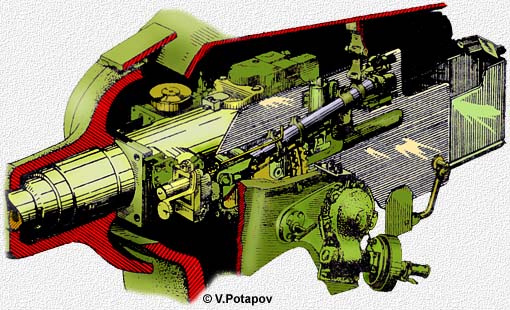
The tanks, armed with the D-5T gun, were noticeably different from vehicles produced later, both in external appearance and in internal construction. It had a two-man turret and a four-man crew overall. The commander's cupola, with a two-leafed folding hatch and revolving on a ball-bearing support, had been moved sharply forward. An MK-4 observation periscope, permitting an all-around field of view, was mounted on the turret roof. The gun and coaxial machine-gun were fired using the TSh-15 telescopic elbow sight and the PTK-5 panoramic telescope. Both sides of the turret had an observation slit covered with triplex glass. The radio was located in the hull with its antenna lead on the right side, exactly the same as on the T-34. The ammunition load consisted of 56 shells and 1,953 machine-gun rounds. The power plant, transmission, and chassis underwent practically no changes. These tanks differed among themselves dependent on when they were produced. For example, early-production vehicles had one turret ventilator, while most of those produced later had two.
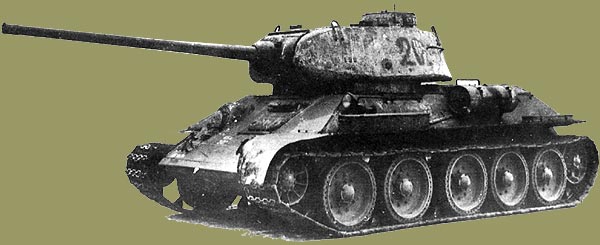
It should be noted that the model examined above did not, apparently, figure into statistical accounting as a T-34-85. In any case, at the present time, there exist significant discrepancies in the literature regarding estimates of the quantity of vehicles produced. The basic figure varies in a range of 500-700 tanks. In actual fact, the number was significantly lower. This can be shown by the fact that in 1943, 283 D-5T guns were produced, 260 in 1944, 543 in all. Of this number, 107 guns were used in IS-1 tanks, a 130 (not more than 100 according to other sources) were used in KV-85 tanks, and a few more were used in vehicle prototypes. Therefore, the number of T-34 tanks produced with the D-5T gun is close to 300 vehicles.
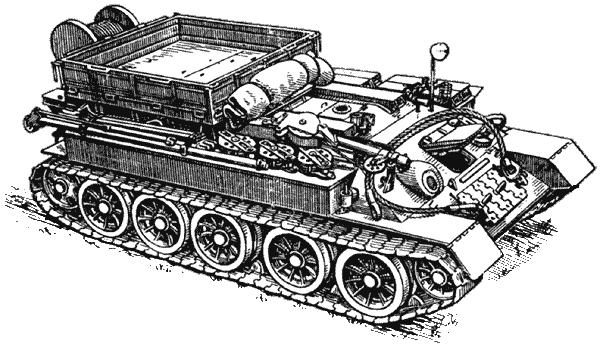
As far as the S-53 gun was concerned, its installation in the Nizhnij Tagil turret did not cause any difficulties. The S-53 was accepted by the Red Army on 1 January 1944, by GOKO order. Start-up production of these guns began in March, full-scale production in May. Correspondingly, in March, the first T-34-85 tanks armed with the S-53 left the shop floor of the Factory #183 in Nizhnij Tagil. Following this lead, the Factory #174 in Omsk and #112 "Krasnoye Sormovo" began production of these vehicles. During this time, a portion of the Krasnoye Sormovo vehicles were equipped with the D-5T gun as before.

Field trials, which continued despite the beginning of production, revealed significant defects in the S-53's recoil mechanism. Artillery factory #92 in Gorkii was ordered to put the finishing touches on it unaided. In November - December 1944, production of this gun began under the designation ZIS-S-53 ("ZIS" was the code for the #92 Stalin Artillery Factory, "S" was the TsAKB's code.). In all, 11,518 S-53 and 14,265 ZIS-S-53 guns were produced in 1944-1945. The latter was installed in both the T-34-85 and the T-44 tanks.
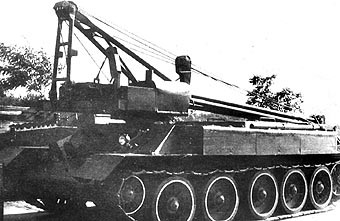 The self-propelled hoisting crane SPK-5. (M.Baryatinsky) |
The "thirty-fours" with the S-53 or ZIS-S-53 gun had three-man turrets, with the commander's cupola moved farther to the rear. Only the new MK-4 type observation device was installed. The commander's PTK-5 panoramic telescope was removed. The engine had been taken care of as well: the "Cyclone" air filters had been replaced with the more efficient "Multi-cyclone" type. The tank's remaining systems and assemblies were practically untouched.
Just as with the T-34, there were some differences among T-34-85 tanks connected with the manufacturing technologies available to the various factories. Turrets differed in the number and placement of the casting joints, as well as the shape of the commander's cupola. The chassis utilized both stamped road wheels, as well as cast ones with internal shock absorption.
In January 1945, the two-leafed hatch on the commander's cupola was replaced with a one-leaf hatch. In late production tanks ("Krasnoye Sormovo" factory), one of the two ventilators installed at the rear of the turret was moved to the central portion, allowing for better ventilation of the crew compartment.
At the end of the war, attempts were made to improve the tank's armament. In 1945, prototype T-34-100 tanks, with the turret ring widened to 1,700mm and armed with 100 mm LB-1 and D-10T guns, underwent field trials. This project had little purpose in so far as the new T-54 medium tank with the 100 mm D-10T gun had already been accepted for service.
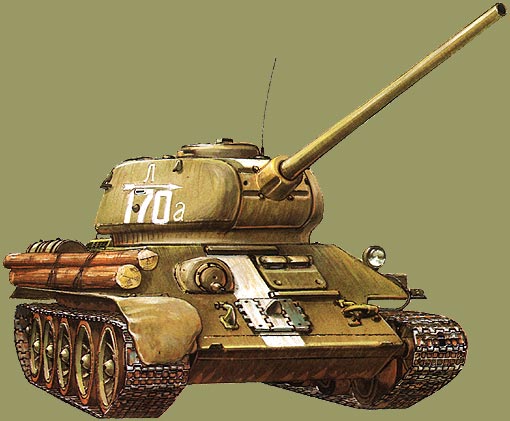
In September 1944 the design bureau of the factory #92 offered "the new 85-mm gun ZIS-85-PM of increased power" with muzzle velocity of an AP projectile 980 m/s. The gun passed factory trials, but didn't pass the governmental trials on the Gorokhovetsky proving pround. Being too expensive the gun was considered as unsuccessful and ineffective. One more attempt to improve the T-34-85's armament was undertaken in 1945, when the TsAKB developed a modification to the ZIS-S-53, the ZIS-S-54, equipped with a single-plane gyroscopic stabilizer. This gun system, however, did not enter mass production. In spring 1945, all further tests with 85-mm tank guns were ceased because the 85-mm caliber was considered as "having no prospects". The more favorable 100-mm caliber was chose.
In the spring of 1944, prototypes of the AT-45 heavy tractor, designed to tow guns up to 22 tons in weight, were manufactured at the former #183 factory, now rebuilt after the liberation of Kharkov and redesignated #75. The AT-45 was designed based on the T-34-85. It was equipped with the same V-2 diesel, though power was decreased to 350 h.p. at 1,400 rpm. The factory built six AT-45 tractors in 1944. Of these, two were sent to the army to be tested in combat conditions. Tractor production ceased in August 1944, in connection with factory #75's preparations to produce the new medium tank model, the T-44. It would not be superfluous to note that this tractor was not the first to be based on the "thirty-four." As far back as August 1940, the AT-42 artillery tractor design was approved. It weighed 17 tons and had a platform carrying capacity of 3 tons. With its 500 h.p. V-2 engine, it could make 33 km/h while towing 15 tons. AT-42 prototypes were manufactured in 1941, but further work on testing and production was cut short by the factory's evacuation from Kharkov.
Mass manufacturing of the T-34-85 in the Soviet Union ceased in 1946 (according to some sources, small-scale production continued at the "Krasnoye Sormovo" factory until 1950). As far as the total number of T-34-85 tanks produced at one or another factory, here, just like for the T-34, there exist areas of considerable discrepancy in the numbers cited in various sources.
| Year | 1944 | 1945 | Total |
| T-34-85 | 10 499 | 12 110 | 22 609 |
| T-34-85 commander | 134 | 140 | 274 |
| OT-34-85 | 30 | 301 | 331 |
| Total | 10 663 | 12 551 | 23 214 |
| Factory | 1944 | 1945 | 1946 | Total |
| #183 | 6 585 | 7 356 | 493 | 14 434 |
| #112 | 3 062 | 3 255 | 1 154 | 7 471 |
| #174 | 1 000 | 1 940 | 1 054 | 3 994 |
| Total | 10 647 | 12 551 | 2 701 | 25 899 |
Comparing figures from the two tables, the discrepancy in the quantity of tanks produced in 1944 is obvious. And this is in spite of the fact that the tables are made up of the most frequently encountered and most reliable figures. In a range of sources, it is possible to encounter other figures for 1945: 6208, 2655, and 1540 tanks respectively. However, these figures reflect tank production for the 1st, 2nd, and 3rd quarters of 1945, meaning at approximately the end of the Second World War. The discrepancy in the figures does not permit the opportunity to state for certain how many T-34 and T-34-85 tanks were produced from 1940 to 1946. The number varies from 61,293 to 61,382 vehicles. Foreign sources cite the following figures for T-34-85 production in the USSR in the post-war years: 1946-5500, 1947-4600, 1948-3700, 1949-900, 1950-300 vehicles. Judging by the number of zeros, the figures are most likely very approximate in character. If, in these sources, the quantity of vehicles produced in 1946 is taken to be inflated by a factor of two, and it is assumed that the remaining figures are likewise inflated, it turns out that 4,750 T-34-85s were produced in 1947-1950. Indeed, this looks like the truth. In fact, is it really possible to surmise that our tank industry stood idle for almost five years? Production of the T-44 was ended in 1947, while factories started mass production of the new T-54, for all practical purposes, only in 1951. As a result, the quantity of T-34s and T-34-85s manufactured exceeds 65 thousand. The majority of the tank's components and assemblies were borrowed from the T-34-76, so I will not dwell in detail on a description of the construction. You may read about that in the separate article. Here I will touch briefly only on the hull and turret of the T-35-85. |
The hull of the tank, as compared with the T-34, did not undergo any fundamental changes. They may all be reduced down to construction simplification. The girder in the bow was removed and the upper and lower frontal plates were joined with a weld. Grommets (hooks) for attaching spare tracks were welded to the upper plate. The aperture for the antenna lead on the upper right plate was removed. Brackets for attaching BDSh smoke pots were fixed to the upper rear plate. Despite claims that periodically occur in print, the armor on production T-34-85's front hull remained unchanged at 45 mm (I have encountered quotes of 60 mm, 75 mm, and even 90 mm). In reality, the armor was increased only on the new turret, to 90 mm.
It consisted of a shaped steel casting. The front had an embrasure for mounting the gun, the coaxial machine-gun, and sight. Externally, four eye-bolts and three handrails were welded to the turret's walls, and six brackets for attaching tarpaulins were welded to the turret's rear wall. One firing port, closed off with an armored cover and latch, was located in each wall of the turret. Early production tanks with the D-5T gun had observation slits above the firing ports; in vehicles produced in 1944-1945, only the observation slit on the right side of the turret, at the loaders position, was kept. T-34-85s produced after the war had no observation slits in the turret. The cast cylindrical commander's cupola was located on the left side of the turret roof. Five observation slits, covered with protective glass, were cut into the cupola's sides for all around vision. The cupola, which could rotate on ball bearings, had a two-leafed folding hatch with an aperture for the observation scope in one of the halves. In tanks produced in 1945-1946, the cupola had a one-leaf hatch and the observation scope was placed in the fixed part of the cupola roof. The loader's round hatchway, with its hatch, was located to the right of the cupola. In addition, the turret had two apertures for mounting the gunner's and loader's MK-4 observation scopes, as well as two ventilation hatches covered with armored caps welded to the turret roof. The crew compartment's ventilators were installed beneath these. The turret was rotated by an electric traverse motor, or by hand. Using the electric motor, maximum turret traverse was 4.2 rpm. |
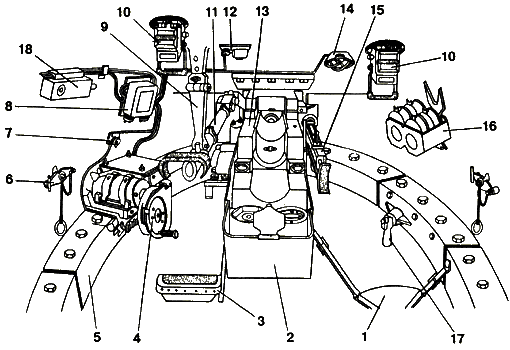
| 1. The loader's station; 2. The cartridge bag; 3. The gunner's station; 4. The turret traversing mechanism; 5. The turret ring; 6. The pistol port's stopper; 7. The backlight button for the gun's deflection; 8. The electrical control unit; 9. The telescopic sight holder; 10. The MK-4 observation sight; 11. The The TNSh-16 telescopic sight; 12. The backlighting for the TNSh-16; 13. The gun; 14. The illumination lamp; 15. The coaxial machine-gun; 16. Machine-gun magazines; 17. The turret locking mechanism; 18. The TPU communication device. |
Early production tanks were equipped with an 85mm D-5T (or D-5-T85) gun 48.8 calibers long (according to other sources, 52 calibers long). The gun's weight was 1,530 kg. Maximum recoil was 320 mm. The gun had a semi-automatic sliding-wedge breech block like the breech block on the F-34 gun. The recoil mechanism consisted of a hydraulic recoil brake and a hydropneumatic recuperator located above the barrel; the recuperator on the right, the recoil brake on the left.
| Parameter | D-5T | ZIS-S-53 |
|---|---|---|
| Caliber, mm | 85 | 85 |
| Barrel length, clb | 51.6 | 54.6 |
| Weight of recoil elements, kg | 980 | 905 |
| The trunnion weight, kg | 1500 | 1150 |
| Max. recoil, m | 0.33 | 0.33 |
| Elevation | - 5° +22° | - 5° +25° |
| Practical rate of fire, shots/min | 5-8* | 6-10 |
Note:
The max ROF during movement was 4 shots/min, the max ROF in static was 10 shots/min.
From March 1944 the 85mm S-53 (ZIS-S-53 from the summer of 1944) model 1944 gun 54.6 calibers long was mounted on the T-34-85 tank. The trunnion weight of the gun without the mantlet was 1,150 kilos. The gun had a semi-automatic vertical sliding-wedge block breech. The triggering mechanism consisted of both electric and mechanical (manual) triggers. The electric trigger was on the elevation flywheel handle, and the manual trigger was on the gun's left safety shield. The tank was equipped with two 7.62 mm DT machine-guns. One was coaxial to the gun, and the other in a ball mount in the front plate of the hull. For direct fire with the D-5T gun, the TSh-15 telescopic sight and the PTK-5 periscopic sight were used. With the S-53 gun, the TSh-16 telescopic sight was used. Since all 85 mm tank guns were based on antiaircraft guns, they used standard rounds for the 85 mm model 1939 anti-aircraft gun: |
| Round index | Projectile index | Type | Fuse | Projectile weight, kg | Description |
|---|---|---|---|---|---|
| UO-365K | O-365K* | fragmentation | KTM-1 | 9.54 | steel case |
| UBR-365 | BR-365 | armor-piercing (APHE) | MD-5 or MD-7 | 9.2 | steel case; tracer |
| UBR-365K | BR-365K | armor-piercing (APBC) | MD-8 | 9.2 | - |
| UBR-365P | BR-365P | sub-caliber | n/a | 4.99 | introduced in February 1944 |
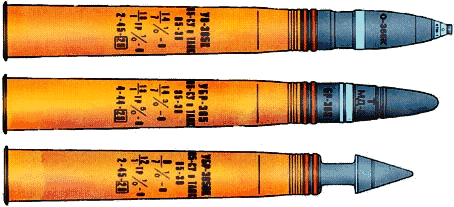
| - the UO-365 fragmentation shell; - the UBR-365 armor-piercing shell; - the UBR-365P armor-piercing subcaliber shell. |
The gun's basic load consisted of 55 gun shells (36 high-explosive, 14 armored piercing, and 5 sub-caliber), and was placed in the hull and turret using three different types of stowage: racks, clamps, and crates (see drawing).
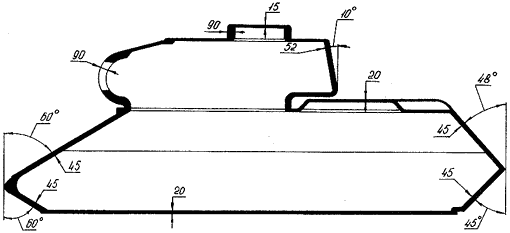
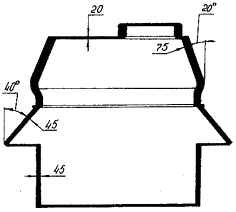
| REFERENCES: T-34 construction features The T-34-85 in action Specification of Soviet tanks Specifications of Soviet tank guns |
Translated by:
Douglas Rauber Sources: "The T-34 tank. Handbook", Voenizdat, 1944; "Reference for maintaining the T-34-85 tank", Voenizdat, 1960; "Artillery armament of the Soviet tanks 1940-1945" Armada #4, 1999; I.Shmelev "The T-34 tank", Weapons and Armament #11-12 1998; "Bronekollektsiya" #1 1998, #4 1999; "Soviet tanks in combat 1941-1945. The T-28, T-34, T-34-85 and T-44", Concord publ. company S.Zaloga, J.Grandsen "T-34 in action" J.Magnuski "Wozy bojowe", LWP, Warsawa, 1985; Cover picture - M.Dmitriev |